
Álava or Araba, officially Araba/Álava, is a province of Spain and a historical territory of the Basque Country, heir of the ancient Lordship of Álava, former medieval Catholic bishopric and now Latin titular see.

Ferdinand IV of Castile called the Summoned, was King of Castile and León from 1295 until his death.

Nájera is a small town, former bishopric and now Latin Catholic titular see, former capital of the Kingdom of Navarre, located in the "Rioja Alta" region of La Rioja, northern Spain, on the river Najerilla. Nájera is a stopping point on the French Way the most popular path on the Way of St James.

Guillermo Haro Barraza was a Mexican astronomer. Through his own astronomical research and the formation of new institutions, Haro was influential in the development of modern observational astronomy in Mexico. Internationally, he is best known for his contribution to the discovery of Herbig–Haro objects.
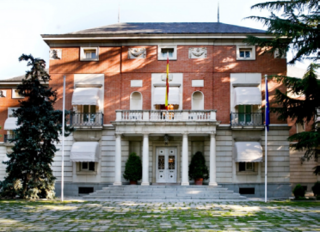
The Palace of Moncloa or Moncloa Palace is the official residence and workplace of the President of the Government, a position usually known in the English language as the Prime Minister of Spain. It is located in Puerta de Hierro Avenue, in the Moncloa-Aravaca district in Madrid. It has been the official residence of the Prime Minister since 1977, when Adolfo Suárez moved the residence from the Palace of Villamejor.

Santa María la Real is a monastery in the small town of Nájera in the La Rioja community, Spain. Originally a royal foundation, it was ceded by Alfonso VI to the Cluniac order. It was an important pilgrimage stop on the Camino de Santiago. It is particularly well known for the woodwork in the choir of the church.

Estrada Courts is a low-income housing project in the Boyle Heights area of Los Angeles, California. It is located between E. Olympic Blvd. on the south and E. 8th St. on the north, and S. Lorena St. on the east and S. Grande Vista Ave. on the west.
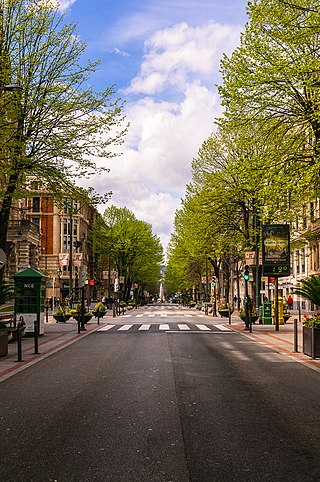
Abando, formerly known as San Vicente de Abando, is one of the eight districts of Bilbao, Basque Country (Spain). It covers most of the city's centre, located on the left bank of the estuary of Bilbao. It is the only district of Bilbao with all of its land completely urbanised. Abando was originally an elizate and also a municipality until 1876, when part of it was annexed to Bilbao, the rest of the elizate's municipal land was integrated into Bilbao in 1890. In 2016 the population was 50,903. Abando is the wealthiest district in Bilbao, with personal and family incomes being well above the citywide average.

Haro is a town and municipality in the northwest of La Rioja province in northern Spain. It produces red wine, and hosts the annual Haro Wine Festival. Its architectural heritage includes the plateresque main entrance of the Church of Santo Tomás, the work of Felipe Vigarny, numerous palaces, and the old town, which was declared a Historic-Artistic Site in 1975.

San Asensio is a municipality and town in the La Rioja autonomous community, northern Spain.

The Haro Wine Festival is a summer festival in the town of Haro, La Rioja, Spain. It features a Batalla de Vino and youth bullfights. It is considered a “Festival of International Tourist Interest” and, therefore, is very tourist friendly. The festival takes place on June 29, the day of the patron saint San Pedro.

Francisco de Haro was a Californio politician, soldier, and ranchero, who served as the 1st and 5th Alcalde of San Francisco. He notably commissioned the first land survey of San Francisco to Jean Jacques Vioget in 1839.
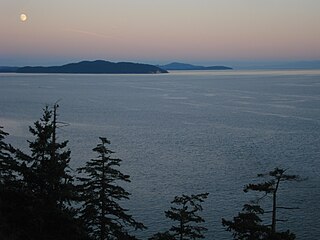
The Haro Strait is one of the main channels connecting the Strait of Georgia to the Strait of Juan de Fuca, separating Vancouver Island and the Gulf Islands in British Columbia, Canada from the San Juan Islands of Washington state in the United States.

During the Age of Discovery, the Spanish Empire undertook several expeditions to the Pacific Northwest of North America. Spanish claims to the region date to the papal bull of 1493, and the Treaty of Tordesillas signed in 1494. In 1513, this claim was reinforced by Spanish explorer Vasco Núñez de Balboa, the first European to sight the Pacific Ocean, when he claimed all lands adjoining this ocean for the Spanish Crown. Spain only started to colonize the claimed territory north of present-day Mexico in the 18th century, when it settled the northern coast of Las Californias.
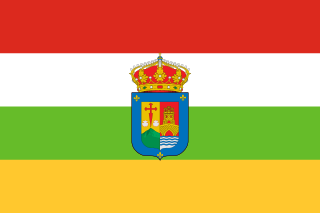
La Rioja is an autonomous community and province in Spain, in the north of the Iberian Peninsula. Its capital is Logroño. Other cities and towns in the province include Calahorra, Arnedo, Alfaro, Haro, Santo Domingo de la Calzada, and Nájera. It has an estimated population of 315,675 inhabitants, making it the least populated autonomous community of Spain.

The Lordship of Biscay was a region under feudal rule in the region of Biscay in the Iberian Peninsula between c.1040 and 1876, ruled by a political figure known as the Lord of Biscay. One of the Basque señoríos, it was a territory with its own political organization, with its own naval ensign, consulate in Bruges and customs offices in Balmaseda and Urduña, from the 11th century until 1876, when the Juntas Generales were abolished. Since 1379, when John I of Castile became the Lord of Biscay, the lordship was integrated into the Crown of Castile, and eventually the Kingdom of Spain.
Rancho Laguna de la Merced was a 2,219-acre (8.98 km2) Mexican land grant, in present-day southwestern San Francisco and northwestern San Mateo County, California.
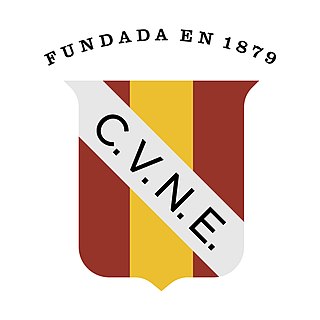
C.V.N.E, Compañía Vinícola del Norte de España is a family winery that was founded in 1879 in the town of Haro in Rioja, Spain. It is within the classification of Denominación de Origen Calificada Rioja.

Villalba de Rioja is a municipality in the autonomous community of La Rioja (Spain), on the southern slopes of the mountains Obarenes. It borders the provinces of Alava and Burgos. Haro 5 km far from the LR-401. By the municipality elapses Esperamalo stream tributary of the Ebro river. The municipality covers an area of 8.96 square kilometres (3.46 sq mi) and as of 2011 had a population of 150 people.
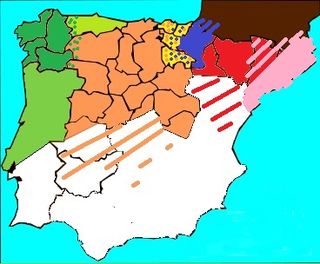
Spanish Romanesque designates the Romanesque art developed in the Hispanic-Christian kingdoms of the Iberian Peninsula in the 11th and 12th centuries. Its stylistic features are essentially common to the European Romanesque although it developed particular characteristics in the different regions of the peninsula. There is no Romanesque art in the southern half of the peninsula because it remained under Muslim rule (Al-Andalus). The examples of Romanesque buildings in the central area of the peninsula are sparse and of the latest period, with virtually no presence south of the Ebro and the Tagus. Most Romanesque buildings can be found in the northern third of the peninsula. Romanesque art was introduced into the peninsula from east to west, so scholars have usually defined regional characteristics accordingly: the "eastern kingdoms" comprising the Pyrenean areas, Catalan Romanesque, Aragonese Romanesque and Navarrese Romanesque, and the "western kingdoms" comprising Castilian-Leonese Romanesque, Asturian Romanesque, Galician Romanesque and Portuguese Romanesque.

















